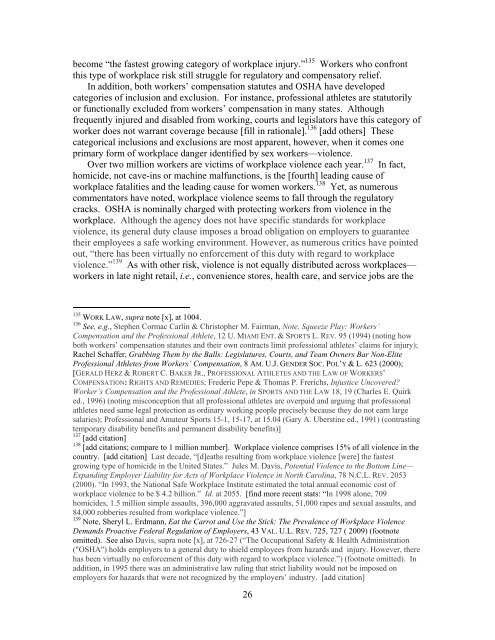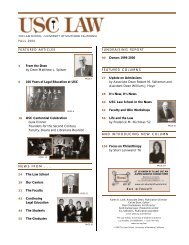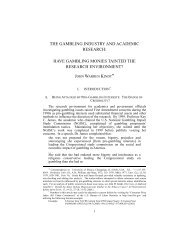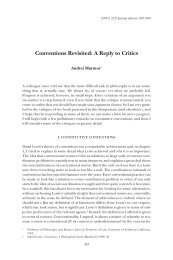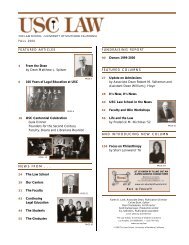1 Regulating Sex Work Adrienne D. Davis VERY ROUGH DRAFT ...
1 Regulating Sex Work Adrienne D. Davis VERY ROUGH DRAFT ...
1 Regulating Sex Work Adrienne D. Davis VERY ROUGH DRAFT ...
Create successful ePaper yourself
Turn your PDF publications into a flip-book with our unique Google optimized e-Paper software.
ecome “the fastest growing category of workplace injury.” 135 <strong>Work</strong>ers who confront<br />
this type of workplace risk still struggle for regulatory and compensatory relief.<br />
In addition, both workers’ compensation statutes and OSHA have developed<br />
categories of inclusion and exclusion. For instance, professional athletes are statutorily<br />
or functionally excluded from workers’ compensation in many states. Although<br />
frequently injured and disabled from working, courts and legislators have this category of<br />
worker does not warrant coverage because [fill in rationale]. 136 [add others] These<br />
categorical inclusions and exclusions are most apparent, however, when it comes one<br />
primary form of workplace danger identified by sex workers—violence.<br />
Over two million workers are victims of workplace violence each year. 137 In fact,<br />
homicide, not cave-ins or machine malfunctions, is the [fourth] leading cause of<br />
workplace fatalities and the leading cause for women workers. 138 Yet, as numerous<br />
commentators have noted, workplace violence seems to fall through the regulatory<br />
cracks. OSHA is nominally charged with protecting workers from violence in the<br />
workplace. Although the agency does not have specific standards for workplace<br />
violence, its general duty clause imposes a broad obligation on employers to guarantee<br />
their employees a safe working environment. However, as numerous critics have pointed<br />
out, “there has been virtually no enforcement of this duty with regard to workplace<br />
violence.” 139 As with other risk, violence is not equally distributed across workplaces—<br />
workers in late night retail, i.e., convenience stores, health care, and service jobs are the<br />
135 WORK LAW, supra note [x], at 1004.<br />
136 See, e.g., Stephen Cormac Carlin & Christopher M. Fairman, Note, Squeeze Play: <strong>Work</strong>ers’<br />
Compensation and the Professional Athlete, 12 U. MIAMI ENT. & SPORTS L. REV. 95 (1994) (noting how<br />
both workers’ compensation statutes and their own contracts limit professional athletes’ claims for injury);<br />
Rachel Schaffer, Grabbing Them by the Balls: Legislatures, Courts, and Team Owners Bar Non-Elite<br />
Professional Athletes from <strong>Work</strong>ers’ Compensation, 8 AM. U.J. GENDER SOC. POL’Y & L. 623 (2000);<br />
[GERALD HERZ & ROBERT C. BAKER JR., PROFESSIONAL ATHLETES AND THE LAW OF WORKERS’<br />
COMPENSATION: RIGHTS AND REMEDIES; Frederic Pepe & Thomas P. Frerichs, Injustice Uncovered?<br />
<strong>Work</strong>er’s Compensation and the Professional Athlete, in SPORTS AND THE LAW 18, 19 (Charles E. Quirk<br />
ed., 1996) (noting misconception that all professional athletes are overpaid and arguing that professional<br />
athletes need same legal protection as ordinary working people precisely because they do not earn large<br />
salaries); Professional and Amateur Sports 15-1, 15-17, at 15.04 (Gary A. Uberstine ed., 1991) (contrasting<br />
temporary disability benefits and permanent disability benefits)]<br />
137 [add citation]<br />
138 [add citations; compare to 1 million number]. <strong>Work</strong>place violence comprises 15% of all violence in the<br />
country. [add citation] Last decade, “[d]eaths resulting from workplace violence [were] the fastest<br />
growing type of homicide in the United States.” Jules M. <strong>Davis</strong>, Potential Violence to the Bottom Line—<br />
Expanding Employer Liability for Acts of <strong>Work</strong>place Violence in North Carolina, 78 N.C.L. REV. 2053<br />
(2000). “In 1993, the National Safe <strong>Work</strong>place Institute estimated the total annual economic cost of<br />
workplace violence to be $ 4.2 billion.” Id. at 2055. [find more recent stats: “In 1998 alone, 709<br />
homicides, 1.5 million simple assaults, 396,000 aggravated assaults, 51,000 rapes and sexual assaults, and<br />
84,000 robberies resulted from workplace violence.”]<br />
139 Note, Sheryl L. Erdmann, Eat the Carrot and Use the Stick: The Prevalence of <strong>Work</strong>place Violence<br />
Demands Proactive Federal Regulation of Employers, 43 VAL. U.L. REV. 725, 727 ( 2009) (footnote<br />
omitted). See also <strong>Davis</strong>, supra note [x], at 726-27 (“The Occupational Safety & Health Administration<br />
("OSHA") holds employers to a general duty to shield employees from hazards and injury. However, there<br />
has been virtually no enforcement of this duty with regard to workplace violence.”) (footnote omitted). In<br />
addition, in 1995 there was an administrative law ruling that strict liability would not be imposed on<br />
employers for hazards that were not recognized by the employers’ industry. [add citation]<br />
26


